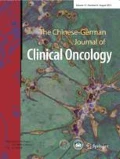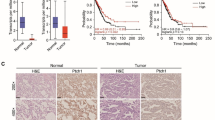Abstract
Objective
Lung cancer has emerged as a leading cause of cancer death in the world. Eyes Absent (EYA) is an important and conserved transcriptional regulator of development. The aim of the present study was to identify the expression of Drosophila Eyes Absent Homologue 2 (EYA2) in non-small cell lung cancer (NSCLC) and to investigate their correlation with clinical parameters.
Methods
Fresh, paired lung samples (n = 59) of NSCLC were obtained by surgical resection at the Department of Thoracic Surgery of the People’s Liberation Army General Hospital. Expression of EYA2 were examined by Western blot and immunohistochemical analysis in specimens of NSCLC and paired normal lung tissue. Clinical data, pathologic result and Ki67 expression were collected and subsequent correlation with EYA2 expression was analyzed.
Results
EYA2 expression was found located in cytoplasm and nucleus, but mostly in cytoplasm. The expression of EYA2 increased in NSCLC by Western blot and immunohistochemistry, which was correlated with histology type, but not correlated with gender, age, pTNM stage, histological differentiation and lymph node metastasis. Compared with normal lung tissue, the expression of EYA2 significantly was up-regulated in lung adenocarcinoma, while no significant difference in lung squamous cell carcinoma. Expression of EYA2 was uncorrelated with expression of Ki67 in NSCLC.
Conclusion
Expression of EYA2 was augmented in lung adenocarcinoma. EYA2 is likely participating in tumorigenesis and development of lung adenocarcinoma as transcriptional activator.
Similar content being viewed by others
References
Molina JR, Yang P, Cassivi SD, et al. Non-small cell lung cancer: epidemiology, risk factors, treatment, and survivorship. Mayo Clin Proc, 2008, 83: 584–594.
Ferlay J, Avtier P, Boniol M, et al. Estimates of the cancer incidence and mortality in Europe in 2006. Ann Oncol, 2007, 18: 581–592.
Fee BE, Doyle CA, Cleveland JL. A novel Eyes Absent 2 protein is expressed in the human eye. Gene, 2002, 285: 221–228.
Clark SW, Fee BE, Cleveland JL. Misexpression of the eyes absent family triggers the apoptotic program. J Biol Chem, 2002, 277: 3560–3567.
Jemc J, Rebay I. The eyes absent family of phosphotyrosine phosphatases: properties and roles in developmental regulation of transcription. Annu Rev Biochem, 2007, 76: 513–538.
Zhang L, Yang N, Huang J, et al. Transcriptional coactivator Drosophila eyes absent homologue 2 is up-regulated in epithelial ovarian cancer and promotes tumor growth. Cancer Res, 2005, 65: 925–932.
Rebay I, Silver SJ, Tootle TL. New vision from Eyes absent: transcription factors as enzymes. Trends Genet, 2005, 21: 163–171.
Coletta RD, Christensen KL, Micalizzi DS, et al. Six1 overexpression in mammary cells induces genomic instability and is sufficient for malignant transformation. Cancer Res, 2008, 68: 2204–2213.
Ford HL, Kabingu EN, Bump EA, et al. Abrogation of the G2 cell cycle checkpoint associated with overexpression of HSIX1: a possible mechanism of breast carcinogenesis. Proc Natl Acad Sci USA, 1998, 95: 12608–12613.
Zhang YZ, Knosp BM, Maccinochie M, et al. A comparative study of EYA1 and EYA4 protein function and its implication in bronchiotorenal syndrome and DFNA10. J Assoc Res Otolaryngol, 2004, 5:295–304.
Xiong WJ, Dabbouseh NM, Rebay I. Interactions with the abelson tyrosine kinase reveal compartmentalization of eyes absent function between nucleus and cytoplasm. Developmental Cell, 2009, 16:271–279.
Embry AC, Glick JL, Linder ME. Reciprocal signaling between the transcriptional co-factor EYA2 and specific members of the Galphai family. Mol Pharmacol, 2004, 66: 1325–1331.
Author information
Authors and Affiliations
Corresponding author
Rights and permissions
About this article
Cite this article
Guo, J., Liang, C., Ding, L. et al. Drosophila Eyes Absent Homologue 2 is up-regulated in lung adenocarcinoma. Chin. -Ger. J. Clin. Oncol. 8, 681–684 (2009). https://doi.org/10.1007/s10330-009-0166-8
Received:
Revised:
Accepted:
Published:
Issue Date:
DOI: https://doi.org/10.1007/s10330-009-0166-8




